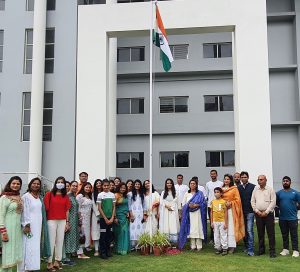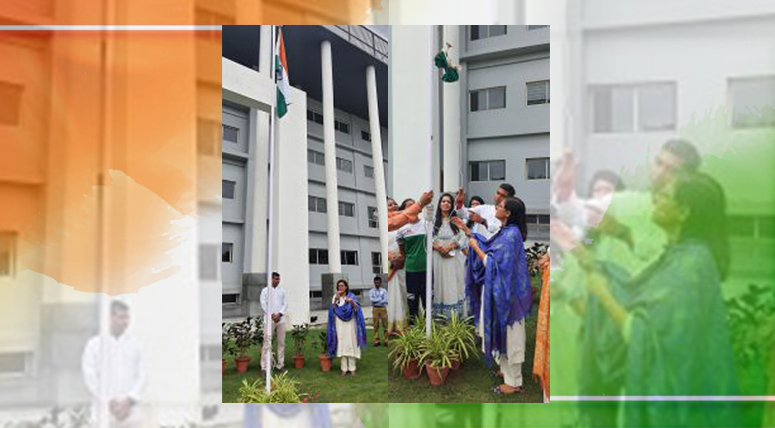“Where the mind is without fear and the head is held high… Where the mind is led forward by thee into ever-widening thought and action into that heaven of freedom, my Father, let my country awake.”
“Where the Mind is Without Fear,” by Rabindranath Tagore appeared as a poem in his Nobel-Winning Anthology “Gitanjali” published by the Indian Society, London in 1912. These lines resonate as inaudible prayer as each neighborhood, each household, and each citizen earns the freedom to own and hoist the Indian National Flag. Each Indian heart beats as one with the symphony of the song created by the bellows of the Tricolor. Coursing through the sweeping wind, it invigorates us with a novel swell of pride and patriotism. A passionate appeal to patriotism reminds us of an era when the poem was penned down. India was suffering under the British Rule and people were praying to be free from the chains of slavery. The poem is written in the form of a prayer to the Almighty for true freedom for his country. To make it clear, the poet prays to the Almighty (my Father) to raise or lift (awake) his country to such heights where freedom would be realized at its best (heaven of freedom). In turn, he is praying that God awakens his countrymen so they come out from the darkness of ignorance, prejudices, disunity, and all other evils. It is not invoking God but using it as a metaphor for the higher self within us.
This interpretation is beautiful, and one can’t resist the urge to remember it as we usher into the 75th year of independence and echo the same spirit. We are rapt with the ‘Har Ghar Tiranga’ campaign under the aegis of Azadi Ka Amrit Mahotsav. Celebrating the ‘HOME COMING’ of our Tiranga, it is magnificent how the citizens of our nation have come together and have enthusiastically hoisted the tricolor to mark the special day. Our relationship with the flag has always been more formal and institutional than personal. Bringing the flag home collectively as a nation thus becomes symbolic of not only an act of individualistic connection to the Tiranga, but also of our commitment to nation-building. The idea behind the initiative is to invoke the feeling of patriotism in people’s hearts and promote awareness about the Indian National Flag.
The origins of flags lie in ancient history. Originally, they may simply have been decorative streamers, or perhaps ceremonial images. They were superior to many other emblems: cheap and simple to make; easy to carry and display; and attracting attention with their lifelike movement in the wind. Flags came to symbolize various leaders, communities, gods, merchant and craft guilds, ships, and towns. A flag often gained the same respect as was accorded to the person or thing that it represented. In a battle, the loss of a flag was a severe blow, capture of the opponent’s a turning point. Flags often bore religious symbols and were used on religious as well as state occasions. The modern national flag arose in the seventeenth century, with the creation of the first modern states. Before that, most countries had only had the flag of the rulers. Some modern national flags even now are used only by the government and military, with a different flag (a civil flag) used by the people.

A flag represents an idea or an ideal. It is neither a mere piece of decoration nor an object to be honored for itself. It is honored for what it represents. Our Tricolor too is held in high esteem for its history; for the sacrifices made by the people; for the qualities for which the country and people stand. Such respect does not depend on the aesthetic appeal of the design, or on its attempt to visually represent the people or politics of a country. If it represents anything tangible, a national flag generally symbolizes the unchanging characteristics of a nation. These can include the geographical location, or perhaps a distinctive physical feature, historical foundation, or (to a lesser degree) the constitutional structure. In democracies, they do not generally represent political affiliations. Respect for the flag is one indication of patriotism. The Indian flag represents the long struggle of our Indian freedom fighters that fought against the British. It depicts our commitment to building our nation. It also signifies our love for peace, integrity, and freedom. Thus, when each Indian sets his heart to hoist the national flag, it is a sign of pride and patriotism. It is a positive affirmation of loyalty and commitment. It marks a country that has confidence in itself and is comfortable with its place in the world, its history, and its future.
Har Ghar Tiranga is the call from the heart of every single Indian to live and die for their motherland. The campaign is to make people aware of their duties as responsible Indian citizens. When we hoist our flag, it instills a sense of patriotism and love for our country. It makes us realize the profundity of the sacrifices made by our soldiers – the ones who guard our boundaries so that we may sleep soundly! Our flag, the tricolor, is a symbol of embodiments of our efforts and commitment to strengthening our nation. The act of bringing our ‘Rashtriya Dhwaj’ home is bound to unite the citizens and make the flame of love and respect for our country shine brighter in our hearts. Everyone, irrespective of religion, region, caste, or creed, should hoist the flag, and experience the personal connection with it getting stronger. This initiative will assist in raising awareness about the significance of our flag and serve to remind all of us of our duty to the nation.

India has achieved significant development in every sphere since its freedom from the shackles of slavery from British Raj. Since then, our country has made tremendous advances in science and technology, medical science, and a range of other sectors. We’ve reached an exciting point in our journey, and it’s time to celebrate. As a result, Azadi Ka Amrit Mahotsav is an endeavor in which every Indian should take part whole heartedly and take pride in being an Indian. As Indians, we must keep close to our heart the liberation struggle leading to an independent free India and fondly nurture it in our hearts.
Our devotion and love towards the nation embody the true spirit of patriotism. It involves a sense of responsibility towards our country. A nation belongs to not only one person, but all, and we must work towards the community’s betterment.
Vivekananda once said “Practical patriotism means not a mere sentiment or even emotion of love of the motherland but a passion to serve our fellow-countrymen. The youth is indeed the most dynamic and vibrant segment of the population in any country.” His message was simple yet powerful. Vivekananda conveyed his ideas directly to the people, especially to the youth. His message broke through the barriers of caste, creed and spoke of a language of universal brotherhood. What he said, captures the great importance of his ideas and ideals among the youth in our country today. The same ideology is nestling in the calling of Har Ghar Tiranga, a metaphor for the patriotic flame that will rekindle amongst the youth.
Culture is often an integral aspect of patriotism. Many patriots take pride in sharing a distinct, common culture, believing it to be central to their national identity and unity. Many are devoted to the preservation of their traditional culture and encouraging cultural assimilation. To ensure this in the nation’s 75th year of Independence, hoisting of the flag by targeted 20 crore households becomes symbolic of not only an act of personal connection to the Tiranga but also an embodiment of nation building. A scholar, a voice of our youth opines that the Tiranga or
Tricolor with the Ashoka Chakra reflects the values of the nation, and its vision of itself, in the past and the future, as a proud, strong, self-reliant State and not a slave to the dictates of global capitalism. The Tiranga represents “One Nation, One Emotion, One Identity”. The flag thus represents the aspirations of our future leaders who will nurture the nation into an evergreen tree, with shoots reaching out skyward to forge an India of technological advancement, but with the roots of core traditional values nourishing it.
Author: Ms. Mamta Wadhwa, Director Principal, MRIS Sector-14





